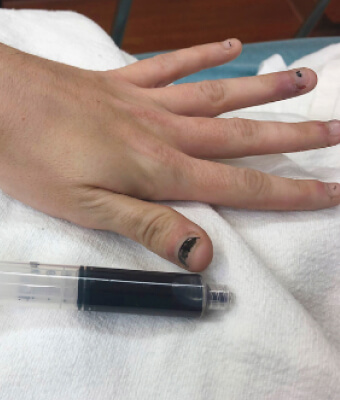Introduction
Osteogenesis imperfecta (OI) type VIII is a rare autosomal-recessive disorder characterized by white sclerae, severe growth deficiency, extreme skeletal under-mineralization, and bulbous metaphysis.1 Despite its prevalence of approximately 1 in 10,000–20,000 births, genetic testing for confirmation is often overlooked, and the diagnosis relies solely on clinical features.2 The reported case emphasizes the need for increased genetic testing to identify potential carriers and prevent misdiagnoses. A case presents the required genetic testing for confirmation, highlighting the importance of a multidisciplinary approach to management.3
Case Presentation3
- A neonate was born to non-consanguineous parents, displaying severe respiratory distress and malformed limbs.
- Clinical features were consistent with OI, but the absence of blue sclerae raised the possibility of metaphysial dysplasia (Figure 1).
- Examination revealed curved limbs, short stature, and signs of severe pneumonia.
- The neonate was treated with antibiotics and supportive care but succumbed to severe pneumonia at ten weeks.

Figure 1: Facial characteristics include a flat nasal bridge and the absence of a conspicuous blue sclera.
Investigations3
- X-rays revealed (Figure 2) multiple fractures of the long bones, rib abnormalities, and bronchopneumonia.
- A cranial ultrasound (Figure 3) showed cystic encephalomalacia, and genetic testing identified a homozygous, likely pathogenic variant in the P3H1 gene, confirming autosomal-recessive OI type VIII.
- Echocardiography and abdominal ultrasound showed normal results, while serum alkaline phosphatase and lactate dehydrogenase levels were elevated.

Figure 2: The skeletal survey reveals fractures present in the ribs, as well as both the humeri and femora.

Figure 3: A cranial ultrasound scan of the occipital lobe reveals characteristics consistent with cystic encephalomalacia (indicated by a black arrow). Additionally, an area of echoic cortex surrounds the infarct, which is now resolving and leaving a distinctive jagged margin of cystic encephalomalacia (shown by white arrows).
Differential Diagnosis3
Metaphysial dysplasia was considered due to the symmetrical short bones, macrocephaly, and absence of blue sclerae.
Treatment3
The infant received suitable antibiotics to combat pneumonia and paracetamol for pain management. Supportive care, including tube feeding and oxygen supplementation, was administered throughout the pneumonia episode.
Outcome and Follow-Up3
Despite stabilization and discharge after three weeks, the baby was readmitted at eight weeks due to severe pneumonia. During this period, the infant experienced sPaO2 levels in the mid-70s, and there was evidence of acidosis with a blood pH of 7.27 and carbon dioxide retention. The neonate’s condition deteriorated further, leading to death at ten weeks. Genetic analysis results were available before the baby’s demise, and the parents received genetic counselling.
Discussion3
OI is a hereditary connective tissue disorder characterized by brittle bones, and OI type VIII is a rare and lethal form. Genetic testing is crucial in confirming the diagnosis, with the variant P3H1 causing autosomal-recessive OI type VIII. The rarity of this variant coordinate, and its potential prevalence among specific populations underscore the need for widespread genetic screening and counselling. A multidisciplinary approach to management is essential, considering the severity of the condition. This case demonstrates the challenges in confirming the diagnosis due to limited resources, emphasizing the importance of early detection and counselling for families affected by OI type VIII.
Conclusion3
This case report highlights the necessity for genetic testing in cases of OI type VIII to avoid misdiagnoses and provide appropriate counselling for affected families. Identifying carriers and offering early interventions through a multidisciplinary approach can improve outcomes for affected individuals. Widespread genetic screening and awareness are essential to address this rare and severe autosomal-recessive disorder.
References
- Cabral WA, Chang W, Barnes AM, et al. Prolyl 3-hydroxylase 1 deficiency causes a recessive metabolic bone disorder resembling lethal/severe osteogenesis imperfecta. Nat Genet 2007; 39: 359-365. DOI: 10.1038/ng1968
- Monti E, Mottes M, Fraschini P, et al. Current and emerging treatments for the management of osteogenesis imperfecta. Ther Clin Risk Manag 2010; 6: 367-381. DOI: 10.2147/tcrm.s5932
- Mariki H, Muze K, Muss F, et al. Osteogenesis imperfecta type VIII: highlighting the need for genetic testing. BMJ Case Rep 2023; 16: e253155. DOI: 10.1136/bcr-2022-253155




